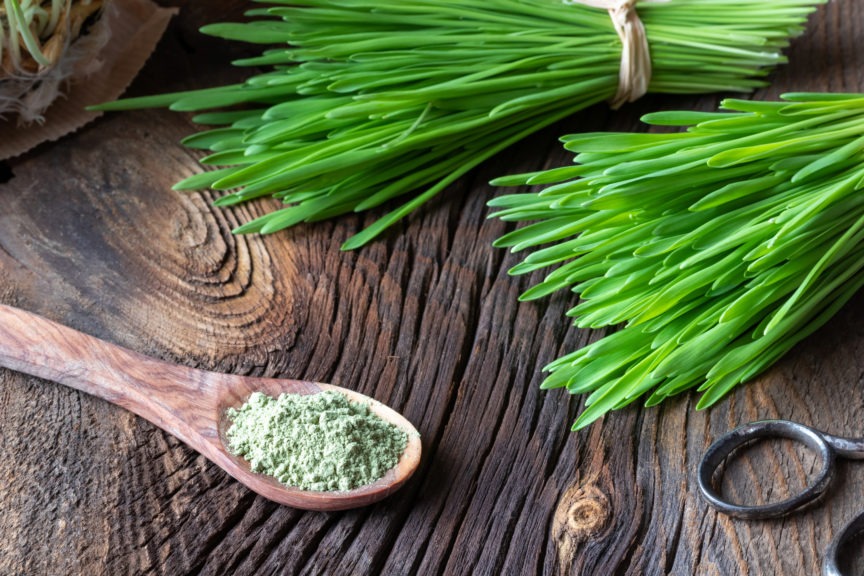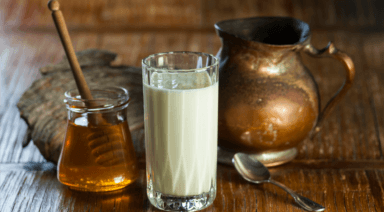The Big Powder Healers: Wheatgrass, Barley Grass, Spirulina & Moringa

In the 1960s and 70s, one type of grass was prevalent. While possession of even a tiny amount may have landed you in jail, your stash was vital to your social status, romantic entanglements, and personal well-being. Luckily, there are several types of grass and algae today that are equally or far more nutritious. These robust plants can remove toxins from your system, drastically reduce or eradicate inflammation, and improve your physical and emotional health. Whether consumed in shakes, shots, pills, or tinctures, wheatgrass, barley grass, spirulina, and moringa might be your new best grass buddies.
“Although few people have ever heard of it today, Moringa could soon become one of the world’s most valuable plants, at least in humanitarian terms.”
— Noel Vietmeyer, US National Academy of Sciences
Wheatgrass
While it might taste like your front lawn, wheatgrass can be a powerful ally against inflammation, stress, and high cholesterol. It has 17 amino acids, eight of which are considered essential. And like all green plants, the chlorophyll in wheatgrass can boost your health in a variety of ways. With one of the highest levels of chlorophyll found in nature, wheatgrass has an insane arsenal of abilities:
- Removes fungus
- Detoxifies your blood
- Energizes your immune system
- Cleans your upper and lower intestines
- Heals your skin
- Reduces the incidence of liver and stomach tumors
- Provides symptomatic relief for arthritis and fibromyalgia
- Helps you lose weight
- Treats hemoglobin disorders, such as anemia and thalassemia
- Prevents and slows cancer growth
- As a natural deodorant, makes you a little less stinky
Other good sources of chlorophyll include green beans, parsley, spinach, mustard greens, alfalfa, spirulina, arugula, peas, and matcha green tea.
Barley Grass
The fiber in barley grass makes it a dominant player against high cholesterol. It also contains minerals like calcium (11x more than milk), iron, magnesium, phosphorus, potassium, and copper, which can improve bone health and production.
Infused with a variety of B vitamins, like B1, B3, B6, and B12, barley grass can enhance your body’s resistance to diseases and infections, drastically lower stress levels, and significantly improve your health. This grass also contains phytochemicals such as flavonoids and folate, which can protect your cells from carcinogens.
Barley grass also has bioactive compounds that include superoxide dismutase and bioflavonoids. These ingredients help barley grass remove free radicals from your body, which will help you reduce inflammation that can cause a variety of diseases, including arthritis, gout, and cancer.
“The food you eat can be either the safest and most powerful form of medicine or the slowest form of poison.” ― Ann Wigmore

Barley grass powder on a spoon with freshly grown barley grass blades
Spirulina
Spirulina is a cyanobacterium, a unique type of bacteria, most often called blue-green algae, the super-power behind many popular super-food powders. From one tablespoon of spirulina powder, your body will receive 4 grams of protein plus healthy doses of vitamins B1, B2, and B3, along with equally beneficial amounts of omega-6 and omega-3 fatty acids, copper, iron, magnesium, potassium, and manganese.
This nutritious algae also has powerful antioxidant and anti-inflammatory properties. When our bodies endure oxidative stress and damage, our DNA and cells can experience degradation. Because it has phycocyanin, an active antioxidant, it can fight free radicals and reduce or extinguish your body’s inflammation. By taking small amounts of spirulina every day (4-8 grams), you can increase your antioxidant enzymes, and reduce oxidative damage, while reducing your chances of heart disease.
Spirulina also lowers your LDL (bad) cholesterol and triglycerides, while elevating your HDL (good) cholesterol.
“Gram for gram, spirulina could be the most nutritious and well-rounded food on the planet, which stores almost indefinitely.” — Gabriel Cousens
Moringa – The Miracle Tree
It is often referred to as Moringa oleifera and is known as the drumstick, horseradish, and ben oil tree. The leaves of this precious friend are highly nutritious and wonderfully healing for your digestive tract. Native to the Himalayan mountains, and passed down through many lineages of healers, shamans, women, cooks, and doctors in India and Africa, this tree has fed and helped millions of people.
Traditionally, moringa lovers have added the plant’s pods of fleshy meat to tinctures, teas, soups, stews, and rice dishes. The leaves and seeds can also be added to salads to add flavor and nutrition. They can also be used as a spice or as a vegetable in place of spinach, green beans, and mustard greens. Every part of the plant is safe and consumable, including its stems, leaves, pods, seeds, flowers, and roots.
Recent years have brought to life a new trend where moringa powder is regularly added to smoothies and shakes. Some people swear by its healing abilities and will toss a tablespoon into a glass of water and throw it back. It has the same bite that you might find in a shot of whiskey, although without the drunk-like, numbing, or euphoric effects.
With beautiful bright green stems and leaves, and remotely related to broccoli, kale, and cabbage, moringa is a superhero shrub. It contains vitamins A and C, along with iron, zinc, calcium, magnesium, and potassium.
The tree’s leaves contain phytochemicals and antioxidants, which, as noted above, provide anti-cancer, anti-arthritis, anti-inflammation, and other remarkable and healing attributes. Moringa has been used to cure everything from liver tumors to typhus and undernourished animals to toothaches.
Wheatgrass, barley grass, and moringa might comprise the powder-trinity that can finally improve your health and increase your life-force. These substances can be found online and in almost any plentiful food or supplement store.
While western medicine might snicker at nutritive powders, they are too busy to research the benefits properly. Only you can know what heals you. In many areas of health, nutrition, and medicine, it’s permissible, even preferable, to trust yourself.
Improving your health doesn’t have to be expensive. You don’t have to purchase trendy packages or combo-supplements from influencers at 10x the cost. You can ignore the hype and fancy logos and find your unique, personal path to wellness. While pharmaceutical companies might offer temporary relief of your symptoms, they also steal from rain forests and resell natural substances at 10,000x their value. It's a scam.
With a little research and focus, you can build a personalized healing profile. You can empower yourself with knowledge and personal trials. While this might take a little time, many of the ailments we all tend to endure are curable through our own exploratory efforts. In the meantime, stay healthy and feed your body and spirit the light-filled foods they deserve!
Novak Djokovic Credits Diet For His Success

One of the familiar faces in TRANSCENDENCE, the new 5 part docu-series coming exclusively to FMTV, is 14 time Grand Slam tennis champion, Novak Djokovic. In Episode 1, titled ‘What’s In Our Food?’, Novak shares how a change to his diet was the catalyst to his 2011 comeback.
In his deeply personal interview, Djokovic shares his struggles on and off the court, which lead him to go down to Jo-Wilfried Tsonga at the 2010 Australian Open. From respiratory problems, an inability to cope with the heat, endurance problems, blurry vision, and a slew of other performance issues, Djokovic was fighting a losing battle with himself.
“I’ve experienced, prior to 2010 Australian Open, many struggles on the court… even though I was training hard, I felt like I was losing that fuel in my tank,” he shares.
Embarking on a life-changing journey with the help of fellow Serb, Dr. Igor Cetojevic, Djokovic found the best fuel for his body, and he hasn’t looked back since. The results were swift and impactful, with the tennis star winning ten tournaments and being crowned world number 1 within the next 12 months.





































